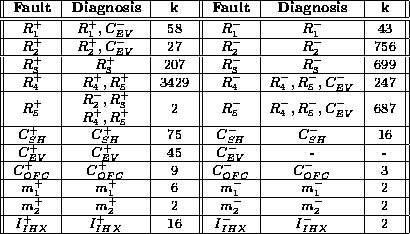Design documents were used to choose relative parameter
values for the sodium cooling loop
so the behaviors generated would be qualitatively accurate.
The monitoring sample rate was set at 20 seconds. Component failures
were modeled by changing model parameters by a factor of 5.
Capacitive and inductive failures produced
abrupt change of flow and pressure, respectively.
The margin of error was set at ![]() for
practical reasons, and signatures of the
for
practical reasons, and signatures of the
![]() order were generated.
Also, fault hypothesis
generation was terminated when more than two derivative (dt) edges were
traversed in the temporal causal graph. This is based on the heuristic
that parameters with more than two derivative edges before a deviating
observation would have caused another observation to deviate first.
The diagnosis engine incorporated the overflow mechanism as part of
the capacitance parameter
order were generated.
Also, fault hypothesis
generation was terminated when more than two derivative (dt) edges were
traversed in the temporal causal graph. This is based on the heuristic
that parameters with more than two derivative edges before a deviating
observation would have caused another observation to deviate first.
The diagnosis engine incorporated the overflow mechanism as part of
the capacitance parameter
![]() . The value unknown was propagated
in the temporal causal graph
whenever an increase in
. The value unknown was propagated
in the temporal causal graph
whenever an increase in ![]() was predicted.
This is a configuration change that cannot be systematically handled by the
current analysis. We
will deal with configuration changes
in more detail in future work.
was predicted.
This is a configuration change that cannot be systematically handled by the
current analysis. We
will deal with configuration changes
in more detail in future work.
The variables ![]() in Fig. 7 and Fig. 8 are typical measurements.
Simulation results (Table 4) showed that all
faults could be accurately diagnosed in a reasonable number of time steps,
k, after a fault was detected.
Precision in diagnosis may improve by considering predicted effects
of order higher than 3,
but as noted before, they take longer to manifest.
in Fig. 7 and Fig. 8 are typical measurements.
Simulation results (Table 4) showed that all
faults could be accurately diagnosed in a reasonable number of time steps,
k, after a fault was detected.
Precision in diagnosis may improve by considering predicted effects
of order higher than 3,
but as noted before, they take longer to manifest.

Table 4: Fault detection and isolation.